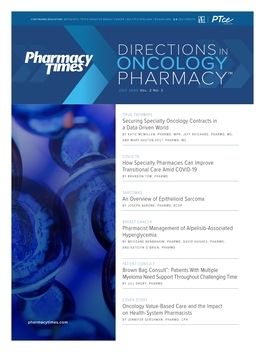Assessment of Veliparib Treatment for Ovarian Cancer Types
Several recent studies presented at the virtual SGO 2020 Annual Meeting on Women’s Cancer looked into veliparib, a potential anticancer PARP inhibitor, for treatment of various types of ovarian cancer.
Several recent studies presented at the virtual Society of Gynecologic Oncology 2020 Annual Meeting on Women’s Cancer looked into veliparib, a potential anticancer PARP inhibitor, for treatment of various types of ovarian cancer.1-4
BRCA Wildtype Ovarian Carcinomas
In a study presented at the meeting assessing veliparib-throughout use with BRCA wildtype (BRCAwt) ovarian carcinomas, the results demonstrated that veliparib was beneficial when added to carboplatin and paclitaxel.1
Furthermore, the combination was found to be beneficial even with low homologous recombination deficiency (HRD) scores. For this reason, the authors concluded that in patients with BRCAwt carcinomas, HRD score was not predictive of patient outcomes for veliparib-throughout versus control.1
In the trial, veliparib dosed concurrently with carboplatin and paclitaxel and continued as maintenance monotherapy resulted in significantly better progression-free survival (PFS) compared with carboplatin and paclitaxel alone in patients with newly diagnosed advanced high-grade serous ovarian carcinoma (HGSC).1
Germline BRCA Mutations
In a study looking at newly diagnosed ovarian cancer, researchers were able to demonstrate that therapy is well tolerated among both BRCA-positive and -negative patients. Germline BRCA mutations positively affect chemotherapy sensitivity in epithelial ovarian cancer but may also affect toxicities experienced by women with the disease.2
The study’s goal was to evaluate how women dichotomized by BRCA status tolerated intravenous or intraperitoneal chemotherapy given with veliparib and bevacizumab in a Gynecologic Oncology Group phase 1 study.2
BRCA-positive patients, when compared with BRCAwt patients, experienced similar rates of anemia, febrile neutropenia, abdominal pain, nausea, vomiting, and peripheral sensory neuropathy. Median PFS was not significantly different between BRCA-positive and BRCAwt patients, although this study’s primary aim was not to evaluate outcomes.2
High-Grade Serous Ovarian Carcinoma
In another study presented at the meeting looking into veliparib use with newly diagnosed HGSC, the researchers assessed the efficacy of veliparib when added to carboplatin and paclitaxel during induction. The results showed that the combination led to a modest increase in CA-125 responses and complete response (CR) in patients with newly diagnosed HGSC.3
According to the results, approximately 67% of participants underwent primary cytoreduction. At baseline, the distribution of CA-125 levels was similar across each study arm assessing veliparib-throughout (carboplatin and paclitaxel + veliparib, then veliparib maintenance), veliparib combo—only (carboplatin and paclitaxel + veliparib, then placebo maintenance), and the control (carboplatin and paclitaxel + placebo, then placebo maintenance). By cycle 3, more patients receiving veliparib achieved a CA-125 response compared with the control group.3
A similar trend was seen among patients undergoing neoadjuvant chemotherapy. Among patients with measurable disease after primary surgery, more patients in veliparib-containing arms had CR compared with the control arm.3
Safety of Veliparib in Combination With Chemotherapy
In a trial assessing the safety of veliparib, the resulting adverse effect (AE) frequencies were found to be generally similar among the whole patient population and biomarker-positive patient subsets.4
During the entire treatment period that combined chemotherapy and maintenance, grade 2 to 4 nonhematologic AEs were predominantly gastrointestinal. Grade 3 to 4 hematologic AEs included neutropenia and anemia in more than one-third of patients.4
The frequency of common AEs was generally comparable in the whole population and the BRCA-mutated and HRD patient subsets; the frequency of AEs leading to dose reduction was also comparable. In the whole population, the prevalence of all-grade neutropenia, anemia, thrombocytopenia, and nausea decreased substantially from cycles 7 to 9 to cycles 10 to 12 (in which cycle 7 was the first cycle of monotherapy maintenance).4
The investigators concluded that the use of veliparib, when dosed concurrently with carboplatin/paclitaxel and continued as maintenance monotherapy, resulted in a significant improvement in PFS compared with carboplatin/paclitaxel alone in patients who were newly diagnosed with stage III to IV high-grade serous ovarian, fallopian tube, and peritoneal cancer.4
REFERENCES
- Swisher EM, Birrer MJ, Moore KN, et al. Exploring the relationship between homologous recombination score and progression-free survival in BRCA wildtype ovarian carcinoma: analysis of veliparib plus carboplatin/paclitaxel in the VELIA study. In: Society of Gynecologic Oncology 2020 Annual Meeting on Women’s Cancer; March 27-March 31, 2020; [online] Abstract LBA6. Accessed April 1, 2020. https://sgo.confex.com/sgo/2020/meetingapp.cgi/Paper/17045
- Gillen J, Moore KN, Schilder R, et al. Tolerability and adverse events experienced by women with ovarian cancer treated with intravenous or intraperitoneal chemotherapy plus veliparib and bevacizumab based on BRCA status. In: Society of Gynecologic Oncology 2020 Annual Meeting on Women’s Cancer; March 27-March 31, 2020; [online]. Abstract 26. Accessed April 14, 2020. https://sgo.confex.com/sgo/2020/meetingapp.cgi/Paper/14689
- O’Malley DM, Moore KN, Brady MF, et al. Anti-tumor activity of veliparib during combination phase with chemotherapy in VELIA study. In: Society of Gynecologic Oncology 2020 Annual Meeting on Women’s Cancer; March 27-March 31, 2020; [online]. Abstract LBA9. Accessed April 1, 2020. https://sgo.confex.com/sgo/2020/meetingapp.cgi/Paper/17070
- Swisher EM, Coleman RL, Bookman MA, et al. Safety of veliparib in combination with chemotherapy and as maintenance in front-line ovarian cancer: results in BRCAm, hrd, and whole populations from the VELIA trial. In: Society of Gynecologic Oncology 2020 Annual Meeting on Women’s Cancer; March 27-March 31, 2020; [online]. Abstract 37. Accessed June 15, 2020 https://sgo.confex.com/sgo/2020/meetingapp.cgi/Paper/15080">https://sgo.confex.com/sgo/2020/meetingapp.cgi/Paper/15080

